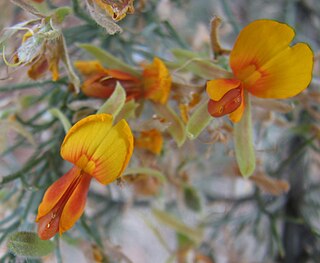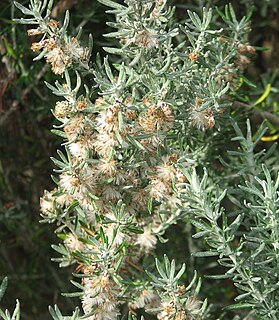
Senecio is a genus of the daisy family (Asteraceae) that includes ragworts and groundsels. The scientific Latin genus name, Senecio, means "old man."

Hakea is a genus of about 150 species of plants in the Family Proteaceae and are endemic to Australia. They are shrubs or small trees with leaves that are sometimes flat, otherwise circular in cross section in which case they are sometimes divided. The flowers are usually arranged in groups in leaf axils and resemble those of other genera, especially Grevillea. Hakeas have woody fruit which distinguishes them from grevilleas which have non-woody fruit which release the seeds as they mature. Hakeas are found in every state of Australia with the highest species diversity being found in the south west of Western Australia.

Persoonia, commonly known as geebungs or snottygobbles, is a genus of about one hundred species of flowering plants in the family Proteaceae. Plants in the genus Persoonia are shrubs or small trees usually with smooth bark, simple leaves and usually yellow flowers arranged along a raceme, each flower with a leaf or scale leaf at the base. The fruit is a drupe.

Baccharis is a genus of perennials and shrubs in the aster family (Asteraceae). They are commonly known as baccharises but sometimes referred to as "brooms", because many members have small thin leaves resembling the true brooms. They are not at all related to these however, but belong to an entirely different lineage of eudicots. B. halimifolia is commonly known as "groundsel bush", however true groundsels are found in the genus Senecio.

Isopogon, commonly known as conesticks, conebushes or coneflowers, is a genus of about forty species of flowering plants in the family Proteaceae, and are endemic to Australia. They are shrubs with rigid leaves, bisexual flowers in a dense spike or "cone" and the fruit is a small, hairy nut.

Hovea is a genus of perennial shrubs which are native to Australia. Species from this genus are occasionally cultivated as ornamental plants. The genus name honours Anton Pantaleon Hove, a Polish plant collector.

Gompholobium, commonly known as glory peas or wedge-peas, is a genus of plants in the pea family, Fabaceae and is endemic to Australia. Most species have compound leaves composed of three leaflets and all have ten stamens which are free from each other and a distinctive arrangement of their sepals.

Jacksonia is a genus of about forty, mostly leafless broom-like shrubs or small trees in the flowering plant family Fabaceae. The genus is endemic to Australia and species occur in a range of habitats in all Australian states except South Australia.

Billardiera is a genus of small vines and shrubs in the family, Pittosporaceae, which is endemic to Australia. The genus was first formally described in 1793 by botanist James Edward Smith who named it in honour of Jacques Labillardière, a French botanist.

Platylobium is a genus of shrubs in the family Fabaceae. Native to south eastern Australia, they occur in a range of habitats of the coastal regions. The genus was first described by James Edward Smith, and is closely allied to Bossiaea, another genus within the Mirbelioids.

Comesperma is a genus of shrubs, herbs and lianas in the family Polygalaceae. The genus is endemic to Australia. It was defined by the French botanist Jacques Labillardière in his 1806 work Novae Hollandiae Plantarum Specimen. The genus name is derived from the Ancient Greek words come ("hair") and sperma ("seed"), and relates to the seeds bearing tufts of hair. The genus is distributed over southern Australia, particularly in the southwest of Western Australia, where 19 species are found. 24 species have been described.

Olearia axillaris is a shrub of the family Asteraceae, found in coastal areas of Australia. Commonly known as the coastal daisybush, or wild rosemary, it was one of the first Australian edible plants to be recognised as such by Europeans.

Senecio angulatus, also known as creeping groundsel and sometimes as Cape ivy, is a succulent plant from the family Asteraceae of the genus Senecio that is native to South Africa. It is a scrambling and a twining herb that can become an aggressive weed once established, making it an invasive species in some countries. However, it is grown as an ornamental plant for its satiny foliage and sweet-scented flowers.

Senecio tamoides, also known as Canary creeper, is a climbing member of the genus Senecio of the family Asteraceae that is native to Southern Africa. It is used as an ornamental plant for its showy yellow, daisy-like flowers in autumn.

Styphelia is a genus of shrubs in the family Ericaceae and is endemic to Australia. Most have minute or small leaves with a sharp tip, single, tube-shaped flowers arranged in leaf axils and with the ends of the petals rolled back with hairs in the inside of the tube.

Olearia phlogopappa commonly known as the dusty daisy-bush or alpine daisy-bush is a species of flowering plant in the family Asteraceae that is commonly found in eastern New South Wales, Victoria and Tasmania. It is a small shrub with greyish-green foliage, daisy-like flowers in white, pink or mauve that can be seen from spring to late summer.

Bedfordia arborescens, known as the blanket leaf, is a shrub or small tree of south eastern Australia. It occurs in or around temperate rainforests in areas of high altitude. The natural range of distribution on the mainland is from the Otway Ranges and Wilsons Promontory in the far south east of the Australian continent to Monga National Park near Braidwood, New South Wales. There is also an isolated occurrence in Tasmania on Cape Barren Island. Other common names are blanket bush, flannel leaf and tree blanketleaf.

Adenanthos sericeus subsp. sericeus, commonly known as coastal woollybush, is a shrub native to the south coast of Western Australia. It has bright red but small and obscure flowers, and very soft, deeply divided, hairy leaves. It is the western subspecies of Adenanthos sericeus, occurring mostly in the vicinity of King George Sound.

Zieria arborescens, commonly known as the tree zieria or stinkwood, is a plant in the citrus family Rutaceae and is endemic to eastern Australia. It is a bushy shrub or small tree with branches that are ridged and scaly or hairy, at least when young. It has leaves composed of three leaflets and groups of flowers with four white petals, the groups usually shorter than the leaves.

Hemiphora is a genus of five species of flowering plants in the mint family, Lamiaceae and is endemic to Western Australia. Plants in this genus are woolly shrubs with warty, hairy leaves and with five petals joined to form a tube-shaped flower with four stamens. These species are similar to those in the genus Chloanthes in that the base of the leaves extends down the stem. They differ from Chloanthes, in that the leaves only extend a short distance down the stem.




















